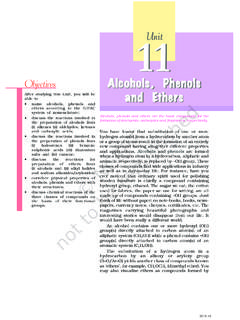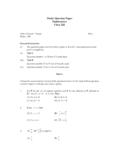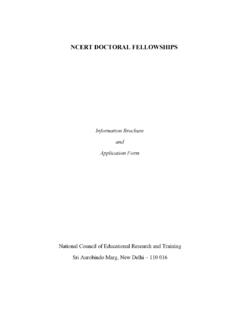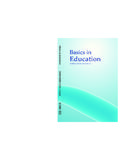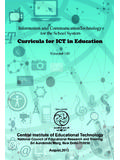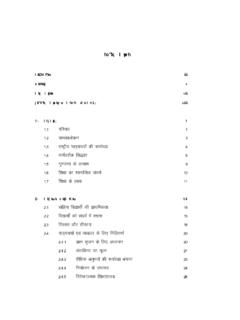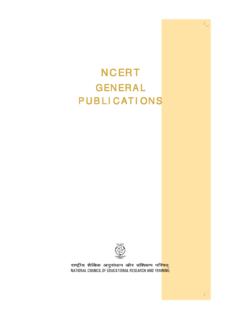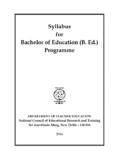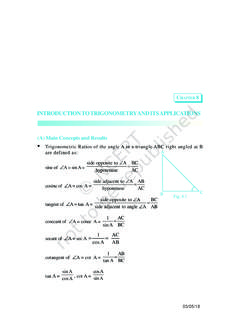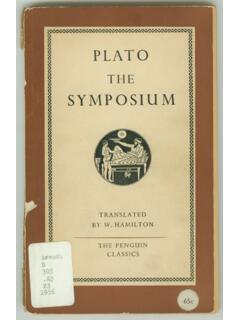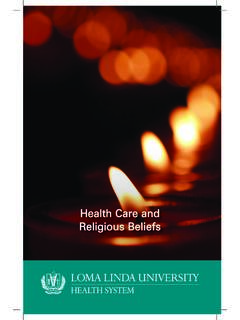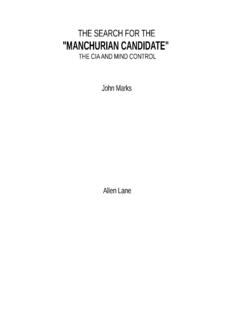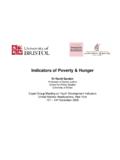Transcription of Chapter 8 science. Progress in physics and chemistry ...
1 Chapter 8 Human Health and DiseaseChapter 9 Strategies for Enhancement inFood ProductionChapter 10 Microbes in Human WelfareBiology is the youngest of the formalised disciplines of naturalscience. Progress in physics and chemistry proceeded muchfaster than in Biology. Applications of physics and chemistry inour daily life also have a higher visibility than those of , twentieth century and certainly twenty-first centuryhas demonstrated the utility of biological knowledge infurthering human welfare, be it in health sector or discovery of antibiotics, and synthetic plant-derived drugs,anaesthetics have changed medical practice on one handand human health on the other hand. Life expectancy ofhuman beings have dramatically changed over the practices, food processing and diagnostics havebrought socio-cultural changes in human communities. Theseare briefly described in the following three chapters of this in August 1925 in Kumbakonam in Tamil Nadu, Monkambu SambasivanSwaminathan did his graduation and post-graduation in Botany fromMadras University.
2 He worked in different capacities in large number ofinstitutions in India and abroad and developed his expertise in geneticsand plant School of Cytogenetics and Radiation Research established at theIndian Agricultural Research Institute (IARI) enabled Swaminathan and histeam to develop short-duration high-yielding varieties of rice including scentedBasmati. He is also known for the development of the concept of cropcafeteria, crop scheduling and genetically improving the yield and initiated collaboration with Norman Borlaug, whichculminated in the Green Revolution through introduction of Mexicanvarieties of wheat in India. This was highly recognised and appreciated. Heis also the initiator of Lab-to-Land , food security and several otherenvironmental programmes. He has been honoured with Padma Bhushanand several other prestigious awards, medals and fellowships by institutionsof SWAMINATHAN(1925)2015-16 Health, for a long time, was considered as a state of bodyand mind where there was a balance of certain humors.
3 This is what early Greeks like Hippocrates as well asIndian Ayurveda system of medicine asserted. It wasthought that persons with blackbile belonged to hotpersonality and would have fevers. This idea was arrivedat by pure reflective thought. The discovery of bloodcirculation by William Harvey using experimental methodand the demonstration of normal body temperature inpersons with blackbile using thermometer disproved the good humor hypothesis of health. In later years, biologystated that mind influences, through neural system andendocrine system, our immune system and that ourimmune system maintains our health. Hence, mind andmental state can affect our health. Of course, health isaffected by (i)genetic disorders deficiencies with which a child isborn and deficiencies/defects which the child inheritsfrom parents from birth;(ii)infections and(iii)life style including food and water we take, rest andexercise we give to our bodies, habits that we have orlack 8 HUMAN HEALTH AND Diseases and Alcohol Abuse2015-16146 BIOLOGYThe term health is very frequently used by everybody.
4 How do wedefine it? Health does not simply mean absence of disease or physicalfitness . It could be defined as a state of complete physical, mental andsocial well-being. When people are healthy, they are more efficient atwork. This increases productivity and brings economic prosperity. Healthalso increases longevity of people and reduces infant and diet, personal hygiene and regular exercise are very importantto maintain good health. Yoga has been practised since time immemorialto achieve physical and mental health. Awareness about diseases andtheir effect on different bodily functions, vaccination (immunisation)against infectious diseases, proper disposal of wastes, control of vectorsand maintenance of hygienic food and water resources are necessary forachieving good the functioning of one or more organs or systems of the body isadversely affected, characterised by various signs and symptoms, we saythat we are not healthy, , we have a disease.
5 Diseases can be broadlygrouped into infectious and non-infectious. Diseases which are easilytransmitted from one person to another, are called infectious diseases are very common and every one of us suffers fromthese at sometime or other. Some of the infectious diseases like AIDS arefatal. Among non-infectious diseases, cancer is the major cause of and alcohol abuse also affect our health COMMON DISEASES IN HUMANSA wide range of organisms belonging to bacteria, viruses, fungi,protozoans, helminths, etc., could cause diseases in man. Such disease-causing organisms are called pathogens. Most parasites are thereforepathogens as they cause harm to the host by living in (or on) them. Thepathogens can enter our body by various means, multiply and interferewith normal vital activities, resulting in morphological and functionaldamage. Pathogens have to adapt to life within the environment of thehost.
6 For example, the pathogens that enter the gut must know a way ofsurviving in the stomach at low pH and resisting the various digestiveenzymes. A few representative members from different groups ofpathogenic organisms are discussed here alongwith the diseases causedby them. Preventive and control measures against these diseases in general,are also briefly typhi is a pathogenic bacterium which causes typhoidfever in human beings. These pathogens generally enter the small intestinethrough food and water contaminated with them and migrate to otherorgans through blood. Sustained high fever (39 to 40 C), weakness,stomach pain, constipation, headache and loss of appetite are some ofthe common symptoms of this disease. Intestinal perforation and deathmay occur in severe cases. Typhoid fever could be confirmed by2015-16 HUMAN HEALTH AND DISEASE147 Widal test.
7 A classic case in medicine, that of Mary Mallon nicknamedTyphoid Mary, is worth mentioning here. She was a cook by professionand was a typhoid carrier who continued to spread typhoid for severalyears through the food she like Streptococcus pneumoniae and Haemophilus influenzaeare responsible for the disease pneumonia in humans which infects thealveoli (air filled sacs) of the lungs. As a result of the infection, the alveoliget filled with fluid leading to severe problems in respiration. The symptomsof pneumonia include fever, chills, cough and headache. In severe cases,the lips and finger nails may turn gray to bluish in colour. A healthyperson acquires the infection by inhaling the droplets/aerosols releasedby an infected person or even by sharing glasses and utensils with aninfected person. Dysentery, plague, diphtheria, etc., are some of the otherbacterial diseases in viruses also cause diseases in human beings.
8 Rhino virusesrepresent one such group of viruses which cause one of the most infectioushuman ailments the common cold. They infect the nose and respiratorypassage but not the lungs. The common cold is characterised by nasalcongestion and discharge, sore throat, hoarseness, cough, headache,tiredness, etc., which usually last for 3-7 days. Droplets resulting fromcough or sneezes of an infected person are either inhaled directly ortransmitted through contaminated objects such as pens, books, cups,doorknobs, computer keyboard or mouse, etc., and cause infection in ahealthy of the human diseases are caused by protozoans too. You mighthave heard about malaria, a disease man has been fighting since manyyears. Plasmodium, a tiny protozoan is responsible for this disease. Differentspecies of Plasmodium (P. vivax, P. malaria and P. falciparum) areresponsible for different types of malaria.
9 Of these, malignant malaria causedby Plasmodium falciparum is the most serious one and can even be us take a glance at the life cycle of Plasmodium (Figure ).Plasmodium enters the human body as sporozoites (infectious form)through the bite of infected female Anopheles mosquito. The parasitesinitially multiply within the liver cells and then attack the red blood cells(RBCs) resulting in their rupture. The rupture of RBCs is associated withrelease of a toxic substance, haemozoin, which is responsible for the chilland high fever recurring every three to four days. When a female Anophelesmosquito bites an infected person, these parasites enter the mosquito sbody and undergo further development. The parasites multiply withinthem to form sporozoites that are stored in their salivary glands. Whenthese mosquitoes bite a human, the sporozoites are introduced into his/her body , thereby initiating the events mentioned above.
10 It is interestingto note that the malarial parasite requires two hosts human andmosquitoes to complete its life cycle (Figure ); the female Anophelesmosquito is the vector (transmitting agent) histolytica is a protozoan parasite in the large intestine ofhuman which causes amoebiasis (amoebic dysentery). Symptoms ofthis disease include constipation, abdominal pain and cramps, stoolswith excess mucous and blood clots. Houseflies act as mechanical carriersand serve to transmit the parasite from faeces of infected person to foodFigure Stages in the life cycle of Plasmodium2015-16 HUMAN HEALTH AND DISEASE149and food products, thereby contaminating water and food contaminated by the faecalmatter are the main source of , the common round worm and Wuchereria,the filarial worm, are some of the helminths which areknown to be pathogenic to man.
